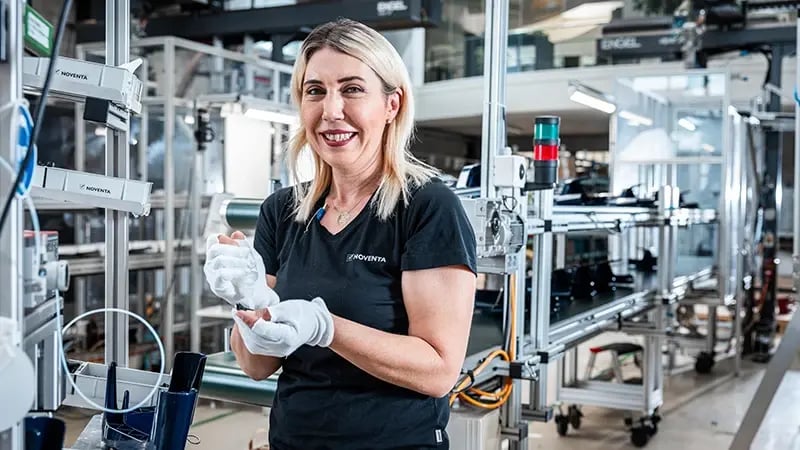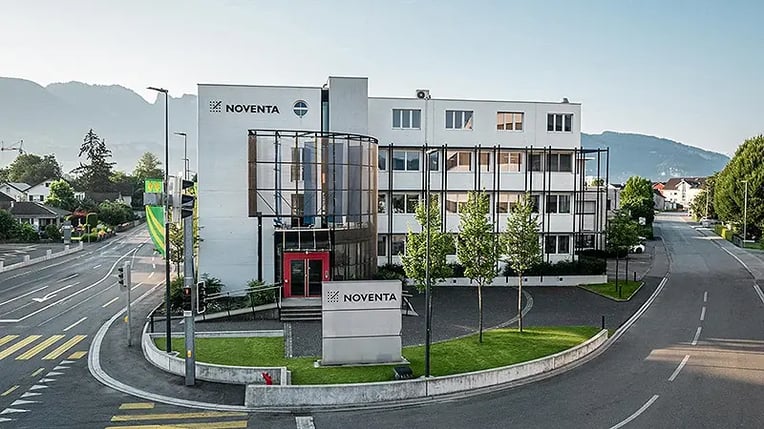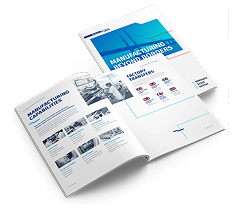In this Q&A, Patrick Besserer, co-owner and chairman of Noventa, shares his perspective on how the manufacturing industry is evolving, from sustainable materials and lean production to smarter, more efficient collaboration across the value chain.
Q: Can you explain a little more about Noventa’s core competencies in product development, industrialisation, plastic part manufacturing, and assembly?
At Noventa, we support customers from single plastic parts to complete Box Build systems. Depending on the project, we act as a manufacturing partner, a development partner, or both.
Our core competencies are:
-
Product development & engineering: Turning ideas into manufacturable solutions, from concept to mechanical and electronic design.
-
Industrialisation: Preparing products for scalable and efficient production, from prototypes to validated processes, with lean principles integrated early.
-
Plastic part manufacturing: High-quality injection-moulded parts for demanding applications, based on deep expertise in materials, tooling, and precision moulding.
-
Assembly: Tailored solutions, from sub-assemblies to complete systems, whether mechanical, electronic, or software-driven.
Everything is based on lean management and flexible, customer-specific supply chains. This makes us a reliable partner from the first idea to long-term series production.
Q: What types of customers or sectors do you typically serve, and what kinds of challenges do you help them solve?
We typically collaborate with customers in the consumer goods, home appliances, industrial, and medical sectors. Most are medium-sized to large companies across Europe and Asia, particularly those requiring high-quality plastic components and complex mechatronic assemblies.
Our customers often face challenges such as limited internal development and engineering capacity, complex product requirements involving mechanical and electronic integration, and tight project timelines with growing pressure to reduce time to market. Many also seek to address supply chain inefficiencies or look for a reliable European manufacturing partner. Additionally, increasing regulatory and sustainability requirements play a significant role in shaping their needs.

Q: What do you consider to be your competitive edge, whether in design, tooling, materials, or speed to market?
Our competitive edge lies in the combination of broad technical expertise, lean thinking, and a strong end-to-end setup. We cover the full value chain in-house, from product engineering and tooling to plastic part manufacturing and assembly.
All product development takes place in Switzerland, where our engineering teams ensure functional, manufacturable solutions. For serial production, we operate three manufacturing sites, - in Switzerland, Romania and Thailand – and produce where it best fits the customer’s needs in terms of cost, volume and logistics.
Customers value our ability to turn complex requirements into production-ready solutions, supported by short decision paths, flexible supply chains, and a pragmatic, partnership-oriented mindset.
Q: How do you typically approach collaboration with customers during the development and industrialisation phases of a project? What key steps could a client of Noventa expect to go through?
At Noventa, we work closely with our customers from the very beginning, with a strong focus on feasibility, lean industrialisation, and long-term production readiness.
A typical project begins with a joint analysis of functional, regulatory, and design requirements. Our engineering and plastics teams then develop manufacturable concepts, select suitable materials, and support the customer through early prototyping.
In the industrialisation phase, we define the production setup: tools, test equipment, assembly processes, and quality assurance. Depending on the project, we build dedicated assembly lines or semi-automated workstations, always with scalability in mind.
Throughout the process, our customers benefit from direct communication, short decision paths, and a pragmatic, solution-oriented mindset. The result is a stable, efficient, and transparent path from idea to series production.
Q: What role does material selection play in the overall success of a plastic part, and how do you guide customers through that process?
Material selection is critical to the performance, durability, and manufacturability of a plastic part. It directly influences function, tolerance, surface finish, cost, and long-term reliability, especially in demanding environments.
We support our customers by assessing all relevant requirements early in the development process. This includes mechanical stress, chemical resistance, regulatory compliance, sustainability goals, and processing characteristics. Based on these criteria, our engineering and plastics teams propose suitable materials and, where needed, validate them through testing or simulation.
By integrating material expertise into product development and tooling design, we help ensure that the selected material supports both product function and efficient production.

Q: Where do you see the greatest opportunities for innovation in plastic part manufacturing over the next few years?
We believe that great opportunities for innovation in plastic part manufacturing lie in the field of sustainability. Over the next few years, I see strong potential in developing advanced recycling technologies, the use of bio-based and circular materials, and the integration of closed-loop production systems. At the same time, lightweight design, energy-efficient manufacturing processes, and digitalisation will play a key role in reducing the overall environmental footprint.
Companies that succeed in combining performance with sustainable solutions will not only gain a competitive edge but also contribute to meeting global climate and resource efficiency goals.
In particular, we see great potential in working with ocean-bound plastics. We recently developed and tested several components using #tide ocean material®, a premium compound made from plastic waste collected from the ocean and shorelines. Processing such materials requires specific expertise in design, tooling, and manufacturing, especially to ensure long-term stability and compliance with industry standards.
By integrating sustainable materials early in development and aligning them with lean, scalable production, we help our customers meet growing environmental expectations without compromising technical performance. In our view, this is more than a trend. It is a decisive shift shaping the future of plastic part manufacturing.
Q: How are you approaching sustainability within your operations or supply chain, particularly in relation to raw materials?
At Noventa, we implemented recycling strategies early on, especially in areas where functional components and raw materials can be recovered and reused. One example is our long-standing cooperation with a correctional facility, where dismantled devices such as hygiene dispensers are disassembled by hand. Used products are manually dismantled, with springs and other functional parts sorted out for reuse. The remaining plastic components are shredded to recover clean, single-grade granulate, which is then reintroduced into selected production processes.
This collaboration not only reduces waste and extends the lifecycle of materials but also creates meaningful work as part of a socially responsible process. In addition, we focus on designing high-quality products that are built to last and can be repaired rather than replaced, reducing unnecessary material use over the product’s lifecycle.
It reflects our broader approach to sustainability: pragmatic, hands-on, and embedded in the way we develop and produce our products.
Q: What trends or shifts are you seeing across the wider manufacturing industry that you believe will impact how plastic components are designed or produced?
The plastic component industry is evolving toward smarter, greener, and more flexible manufacturing. The integration of AI, sustainable materials, and advanced design and moulding techniques is reshaping how parts are developed and produced, positioning companies that adopt these trends for competitive advantage.
Q: Looking ahead, what are your strategic priorities for growth, and how do you see Noventa evolving over the next 5–10 years?
Over the next decade, Noventa will focus on five key priorities: driving innovation in high-performance materials and products, leveraging digital technologies for smarter production, and embedding sustainability into everything we do. At the same time, we will continue to expand our global customer portfolio and invest in our people, ensuring that Noventa remains a resilient and forward-looking partner for the years to come.

Noventa's headquarters in Switzerland
About Noventa
Noventa AG turns bright ideas into successful products. The company develops and manufactures plastic components and complete systems, covering the entire value chain from design and engineering to production and assembly. With locations in Switzerland, Eastern Europe, and Asia, Noventa offers comprehensive expertise under one roof.
Noventa AG, Sonnenstrasse 1, CH-9444 Diepoldsau, Switzerland
T +41 71 737 95 00


